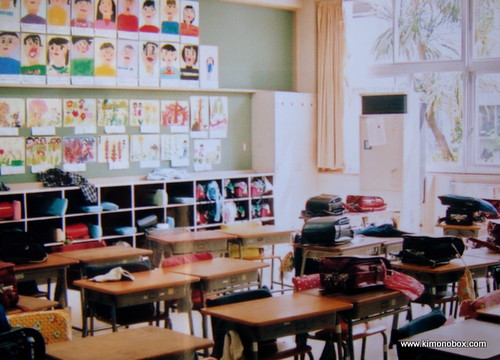Education in Japan (Natalie Collar)
For many Japanese people, just hearing the word kyūshoku brings back lovely memories of childhood and the delicious, homemade lunches they ate at school. Although school lunch has pleased many generations in Japan, many children in other countries, especially the United States, are disappointed at school lunches and pack their own lunch.
Just what makes Japanese school lunch so memorable? Perhaps it is not only what is served at lunch but also how the food is served.
In most public schools, the lunch is prepared fresh daily at the school, or it is delivered from a cooking center close by. Once the food arrives at the school, each class’s portion is grouped together to await pick up from hungry students. Depending on the size of the class, each student may have a daily role in lunch preparation, or students’ roles rotate throughout the school year. These roles include going to pick up the food, dishing out equal portions to each student, or cleaning the dishes and returning them to the pick-up area.
Once the fourth period bell rings, the sound of feet dashing down to collect the food fills the hallways. Unlike schools in the U.S., most Japanese elementary and middle schools do not have a cafeteria, so the students use their desks as lunch tables and eat in the classroom. Once each student is served, all students sit at their desk and wait until it is time to say for them along with the rest of the school to say pre-meal greeting, itadakimasu. Students are usually given a set amount of time to finish eating their lunch and cleaning up after themselves. Once again, the whole school simultaneously shows their gratitude for the meal and its preparation by saying gochisōsamadeshita. With that, school lunch is essentially finished.
While the student involvement in the preparation and cleanup of the meals is certainly a unique part of kyūshoku, the effort put into planning every meal is also noteworthy. At each school or grouping of schools, there is usually a head nutritionist who specializes in planning the meals carefully. Each meal will ideally contain one third of the recommended daily amount of various vitamins and minerals. Wherever possible, nutritionists also strive to include locally-grown food, which provides a learning opportunity for the students.
At an elementary school in Tokyo, students have the opportunity to learn about where the food in their lunches appears during a social studies class. The fourth graders, for example, met one of the fisherman responsible for supplying the flying fish that was fried and included in their lunch. The organizers of this event are hoping to instill in their students a sense for eating healthfully and responsibly that will serve them well in the future.
Other events related to school nutrition are held in the community to educate parents and other community members. School lunch tasting events are common in areas throughout Japan and draw attention to the efforts of the nutritionists and food preparation staff. They also provide adults with a chance to relive one of their favorite childhood memories of eating kyūshoku. In Ichinoseki City, Iwate Prefecture, a similar event was held at the Board of Education with the hopes of strengthening the ability of teachers, parents, and others to appropriately teach children about correct manners and cultural habits of the area. Attendees spoke highly of the quality of food made by the staff. In fact, one grandmother was so impressed that she said that she wanted to tell her grandchild just how much effort is being put into the planning and preparation of each meal.
Day in and day out, many people work diligently to plan and prepare each school lunch. Students also have a daily role in serving the lunch. In these ways, Japanese school lunch is quite special and the experiences shared over lunch tend to stick with students for the rest of their lives.
- 岩手日日新聞社(電子版)「栄養バランス実感 学校給食 住民向けに試食会」, 2016/10/15. http://www.iwanichi.co.jp/ichinoseki/18149.html
- 読売新聞(電子版)「教育ルネサンス 学校給食60年 (6)『食育の教材』大きな役割…授業と連携」, 2014/11/22. http://www.yomiuri.co.jp/kyoiku/renai/20141117-OYT8T50067.html
- FAST JAPAN, 「不只是吃而已!從學校午餐看日本人的『給食』文化」, 2016/04/06. https://fastjapan.com/cht/p105274





